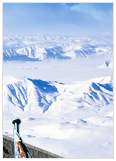-
About the Ministry
About the Ministry
- Press
- Countries & Regions
- Policy Information
- Life In Korea
The Antarctic Treaty System
- Indo-Pacific Strategy
- Korean Peninsula
- Treaties·International Law
- Development Cooperation
- International Organization
- Human Rights
- Environment
- Bilateral Economic Relations
- Public Diplomacy
-
The Antarctic Treaty System

Antarctica is the fifth largest continent on earth and accounts for one-tenth of its total land surface. 98% of the surface of Antarctica is covered with polar icecaps 2,160meter thick on average, which contains about 90% of the earth’s all fresh water in the form of ice. Antarctica is also a land rich in marine living resource, with its ice playing an important role in controlling the temperature of the oceans. Indeed, Antarctica is one of the few remaining unspoiled regions in the world. To protect and preserve the precious Antarctic environment, the Antarctic Treaty was adopted in 1959 and took effect in 1961. As of March 2018, 53 countries have signed up as Parties of the Treaty.
The Antarctic Treaty System establishes the legal status of Antarctica and consists of the following treaties: the “Antarctic Treaty,” “Protocol on Environmental Protection to the Antarctic Treaty,” “Convention on the Conservation of Antarctic Marine Living Resources,” and “Convention for the Conservation of Antarctic Seals.” The Antarctic Treaty put all territorial claims in abeyance and stipulated that only peaceful and scientific activities are allowed to be conducted in Antarctica.
As the central consultative body of the Treaty, the Antarctic Treaty Consultative Meeting(ATCM) promotes cooperation among the consultative parties with the objective of furthering the purpose and principles of the Antarctic Treaty. Other organizations, such as the “Commission for the Conservation of Antarctic Marine Living Resources,” the “Scientific Committee on Antarctic Research,” and the “Council of Managers of National Antarctic Program” are also deeply involved in the Antarctic Treaty System.
Under the Antarctic Treaty System, only the small number of member countries can carry out major activities in the South Pole region, prompting some countries to argue that Antarctica should be designated as “Common Heritage of Mankind” to be placed under responsibility of the UN. But this proposal met with fierce opposition by the Treaty member states, and as a result the Antarctic Treaty System is currently functioning independently from the UN. But as described above, the territorial claims laid by seven countries (Argentina, Australia, Chile, France, New Zealand, Norway, and the United Kingdom) was put into abeyance.
The Antarctic Treaty System also includes various protocols and committees for environmental protection effort and the advancement of scientific activities in Antarctica. For example, the Protocol on Environmental Protection to the Antarctic Treaty, which was adopted in 1991 and came into force on January 14, 1998, prohibits contracting parties from mining and any activities that are deemed damaging to Antarctica’s environment in accordance with the environmental impact assessment. The Committee for Environment Protection is in charge of the preservation of environmental, scientific, historic, and aesthetical, and natural values of Antarctica and coordinates international cooperation for Antarctica’s environmental protection. Moreover, the Annex VI to the Protocol on Environmental Protection held contracting parties liable to reparation of any environmental damage caused by the parties. In short, the Antarctic Treaty System is designed to protect Antarctica’s natural environment.
The Republic of Korea (ROK) first launched its activities in Antarctica with a krill fishing survey in 1978. It acceded to the Convention on the Conservation of Antarctic Marine Living Resources (CCAMLR) in 1985 and then the Antarctic Treaty in 1986. In 1988, ROK established a Korean scientific research station called the King Sejong Station on Antarctica’s King George Island. Having recognized for its vigorous activities and significant scientific achievements on Antarctica, ROK attained membership in the Antarctic Treaty Consultative Party on October 18, 1989. The ROK government hosted the 19th Antarctic Treaty Consultative Meeting in Seoul in 1995, and ever since has steadily strengthened its participation in the Antarctic Treaty System. In 2014, ROK built its 2nd Antarctic research station called Jang Bogo Research Station on Tera Nova Bay.
With its firm commitment to the protection of marine living resources, the ROK government will continue to maintain a balance between the rational use of marine living resources and the broader benefits to the entire mankind by protecting Antarctica’s natural environment.




